Weaknesses in Inventory Control
VerifiedAdded on 2023/01/19
|8
|3544
|23
AI Summary
This document discusses the weaknesses in inventory control and their implications. It highlights the importance of proper internal control in inventory management and provides suggestions for improvement.
Contribute Materials
Your contribution can guide someone’s learning journey. Share your
documents today.
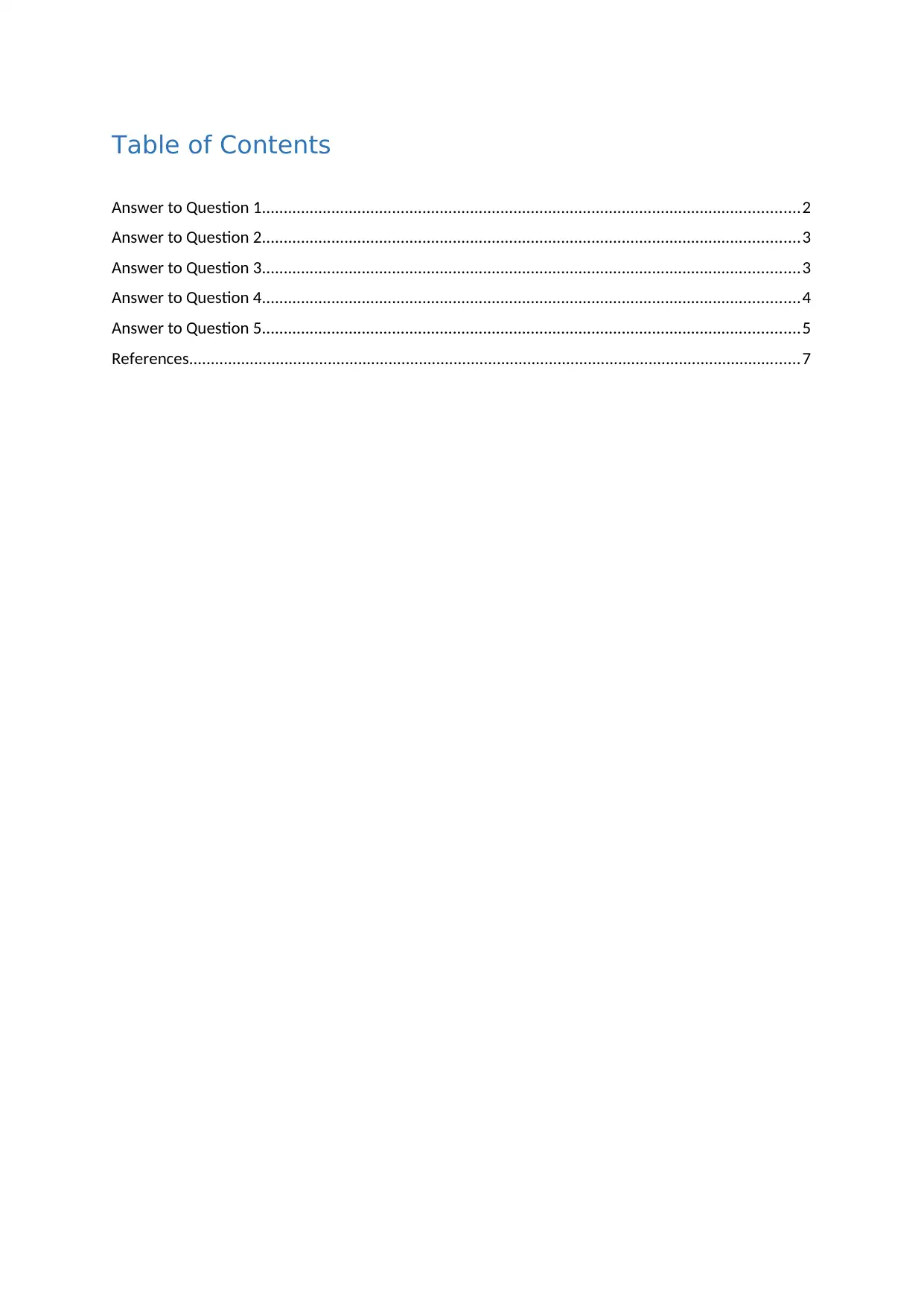
Table of Contents
Answer to Question 1............................................................................................................................2
Answer to Question 2............................................................................................................................3
Answer to Question 3............................................................................................................................3
Answer to Question 4............................................................................................................................4
Answer to Question 5............................................................................................................................5
References.............................................................................................................................................7
Answer to Question 1............................................................................................................................2
Answer to Question 2............................................................................................................................3
Answer to Question 3............................................................................................................................3
Answer to Question 4............................................................................................................................4
Answer to Question 5............................................................................................................................5
References.............................................................................................................................................7
Secure Best Marks with AI Grader
Need help grading? Try our AI Grader for instant feedback on your assignments.
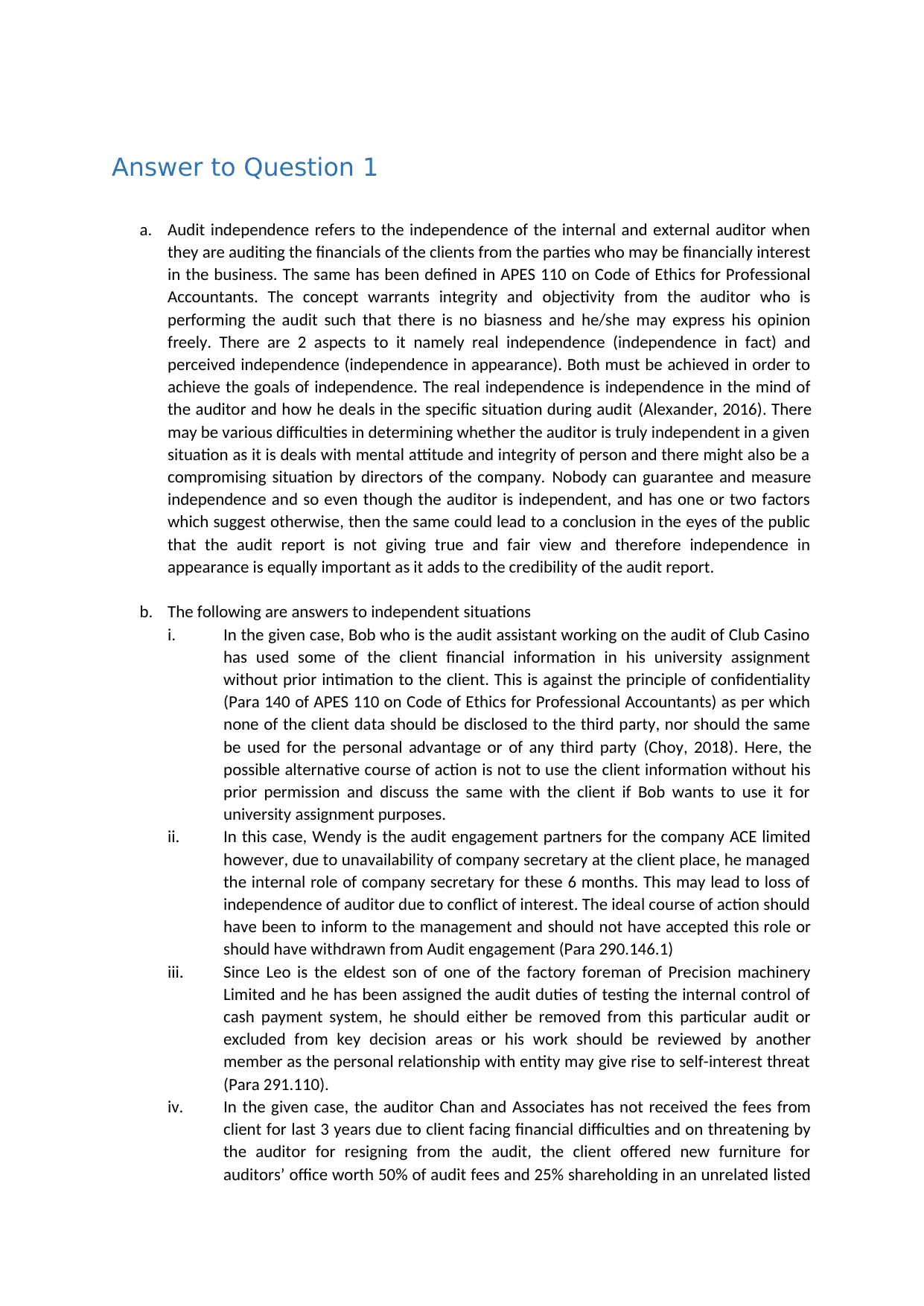
Answer to Question 1
a. Audit independence refers to the independence of the internal and external auditor when
they are auditing the financials of the clients from the parties who may be financially interest
in the business. The same has been defined in APES 110 on Code of Ethics for Professional
Accountants. The concept warrants integrity and objectivity from the auditor who is
performing the audit such that there is no biasness and he/she may express his opinion
freely. There are 2 aspects to it namely real independence (independence in fact) and
perceived independence (independence in appearance). Both must be achieved in order to
achieve the goals of independence. The real independence is independence in the mind of
the auditor and how he deals in the specific situation during audit (Alexander, 2016). There
may be various difficulties in determining whether the auditor is truly independent in a given
situation as it is deals with mental attitude and integrity of person and there might also be a
compromising situation by directors of the company. Nobody can guarantee and measure
independence and so even though the auditor is independent, and has one or two factors
which suggest otherwise, then the same could lead to a conclusion in the eyes of the public
that the audit report is not giving true and fair view and therefore independence in
appearance is equally important as it adds to the credibility of the audit report.
b. The following are answers to independent situations
i. In the given case, Bob who is the audit assistant working on the audit of Club Casino
has used some of the client financial information in his university assignment
without prior intimation to the client. This is against the principle of confidentiality
(Para 140 of APES 110 on Code of Ethics for Professional Accountants) as per which
none of the client data should be disclosed to the third party, nor should the same
be used for the personal advantage or of any third party (Choy, 2018). Here, the
possible alternative course of action is not to use the client information without his
prior permission and discuss the same with the client if Bob wants to use it for
university assignment purposes.
ii. In this case, Wendy is the audit engagement partners for the company ACE limited
however, due to unavailability of company secretary at the client place, he managed
the internal role of company secretary for these 6 months. This may lead to loss of
independence of auditor due to conflict of interest. The ideal course of action should
have been to inform to the management and should not have accepted this role or
should have withdrawn from Audit engagement (Para 290.146.1)
iii. Since Leo is the eldest son of one of the factory foreman of Precision machinery
Limited and he has been assigned the audit duties of testing the internal control of
cash payment system, he should either be removed from this particular audit or
excluded from key decision areas or his work should be reviewed by another
member as the personal relationship with entity may give rise to self-interest threat
(Para 291.110).
iv. In the given case, the auditor Chan and Associates has not received the fees from
client for last 3 years due to client facing financial difficulties and on threatening by
the auditor for resigning from the audit, the client offered new furniture for
auditors’ office worth 50% of audit fees and 25% shareholding in an unrelated listed
a. Audit independence refers to the independence of the internal and external auditor when
they are auditing the financials of the clients from the parties who may be financially interest
in the business. The same has been defined in APES 110 on Code of Ethics for Professional
Accountants. The concept warrants integrity and objectivity from the auditor who is
performing the audit such that there is no biasness and he/she may express his opinion
freely. There are 2 aspects to it namely real independence (independence in fact) and
perceived independence (independence in appearance). Both must be achieved in order to
achieve the goals of independence. The real independence is independence in the mind of
the auditor and how he deals in the specific situation during audit (Alexander, 2016). There
may be various difficulties in determining whether the auditor is truly independent in a given
situation as it is deals with mental attitude and integrity of person and there might also be a
compromising situation by directors of the company. Nobody can guarantee and measure
independence and so even though the auditor is independent, and has one or two factors
which suggest otherwise, then the same could lead to a conclusion in the eyes of the public
that the audit report is not giving true and fair view and therefore independence in
appearance is equally important as it adds to the credibility of the audit report.
b. The following are answers to independent situations
i. In the given case, Bob who is the audit assistant working on the audit of Club Casino
has used some of the client financial information in his university assignment
without prior intimation to the client. This is against the principle of confidentiality
(Para 140 of APES 110 on Code of Ethics for Professional Accountants) as per which
none of the client data should be disclosed to the third party, nor should the same
be used for the personal advantage or of any third party (Choy, 2018). Here, the
possible alternative course of action is not to use the client information without his
prior permission and discuss the same with the client if Bob wants to use it for
university assignment purposes.
ii. In this case, Wendy is the audit engagement partners for the company ACE limited
however, due to unavailability of company secretary at the client place, he managed
the internal role of company secretary for these 6 months. This may lead to loss of
independence of auditor due to conflict of interest. The ideal course of action should
have been to inform to the management and should not have accepted this role or
should have withdrawn from Audit engagement (Para 290.146.1)
iii. Since Leo is the eldest son of one of the factory foreman of Precision machinery
Limited and he has been assigned the audit duties of testing the internal control of
cash payment system, he should either be removed from this particular audit or
excluded from key decision areas or his work should be reviewed by another
member as the personal relationship with entity may give rise to self-interest threat
(Para 291.110).
iv. In the given case, the auditor Chan and Associates has not received the fees from
client for last 3 years due to client facing financial difficulties and on threatening by
the auditor for resigning from the audit, the client offered new furniture for
auditors’ office worth 50% of audit fees and 25% shareholding in an unrelated listed
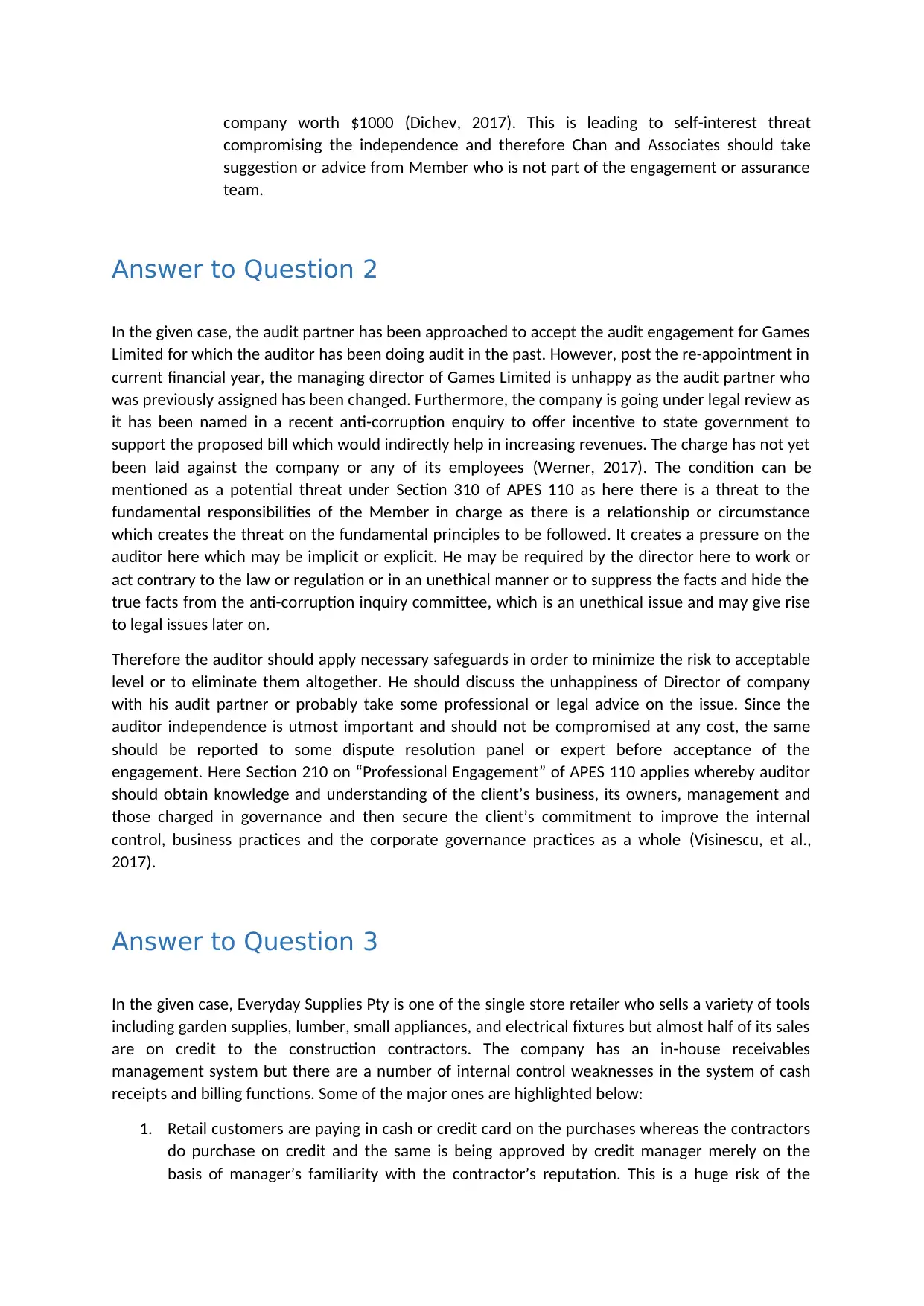
company worth $1000 (Dichev, 2017). This is leading to self-interest threat
compromising the independence and therefore Chan and Associates should take
suggestion or advice from Member who is not part of the engagement or assurance
team.
Answer to Question 2
In the given case, the audit partner has been approached to accept the audit engagement for Games
Limited for which the auditor has been doing audit in the past. However, post the re-appointment in
current financial year, the managing director of Games Limited is unhappy as the audit partner who
was previously assigned has been changed. Furthermore, the company is going under legal review as
it has been named in a recent anti-corruption enquiry to offer incentive to state government to
support the proposed bill which would indirectly help in increasing revenues. The charge has not yet
been laid against the company or any of its employees (Werner, 2017). The condition can be
mentioned as a potential threat under Section 310 of APES 110 as here there is a threat to the
fundamental responsibilities of the Member in charge as there is a relationship or circumstance
which creates the threat on the fundamental principles to be followed. It creates a pressure on the
auditor here which may be implicit or explicit. He may be required by the director here to work or
act contrary to the law or regulation or in an unethical manner or to suppress the facts and hide the
true facts from the anti-corruption inquiry committee, which is an unethical issue and may give rise
to legal issues later on.
Therefore the auditor should apply necessary safeguards in order to minimize the risk to acceptable
level or to eliminate them altogether. He should discuss the unhappiness of Director of company
with his audit partner or probably take some professional or legal advice on the issue. Since the
auditor independence is utmost important and should not be compromised at any cost, the same
should be reported to some dispute resolution panel or expert before acceptance of the
engagement. Here Section 210 on “Professional Engagement” of APES 110 applies whereby auditor
should obtain knowledge and understanding of the client’s business, its owners, management and
those charged in governance and then secure the client’s commitment to improve the internal
control, business practices and the corporate governance practices as a whole (Visinescu, et al.,
2017).
Answer to Question 3
In the given case, Everyday Supplies Pty is one of the single store retailer who sells a variety of tools
including garden supplies, lumber, small appliances, and electrical fixtures but almost half of its sales
are on credit to the construction contractors. The company has an in-house receivables
management system but there are a number of internal control weaknesses in the system of cash
receipts and billing functions. Some of the major ones are highlighted below:
1. Retail customers are paying in cash or credit card on the purchases whereas the contractors
do purchase on credit and the same is being approved by credit manager merely on the
basis of manager’s familiarity with the contractor’s reputation. This is a huge risk of the
compromising the independence and therefore Chan and Associates should take
suggestion or advice from Member who is not part of the engagement or assurance
team.
Answer to Question 2
In the given case, the audit partner has been approached to accept the audit engagement for Games
Limited for which the auditor has been doing audit in the past. However, post the re-appointment in
current financial year, the managing director of Games Limited is unhappy as the audit partner who
was previously assigned has been changed. Furthermore, the company is going under legal review as
it has been named in a recent anti-corruption enquiry to offer incentive to state government to
support the proposed bill which would indirectly help in increasing revenues. The charge has not yet
been laid against the company or any of its employees (Werner, 2017). The condition can be
mentioned as a potential threat under Section 310 of APES 110 as here there is a threat to the
fundamental responsibilities of the Member in charge as there is a relationship or circumstance
which creates the threat on the fundamental principles to be followed. It creates a pressure on the
auditor here which may be implicit or explicit. He may be required by the director here to work or
act contrary to the law or regulation or in an unethical manner or to suppress the facts and hide the
true facts from the anti-corruption inquiry committee, which is an unethical issue and may give rise
to legal issues later on.
Therefore the auditor should apply necessary safeguards in order to minimize the risk to acceptable
level or to eliminate them altogether. He should discuss the unhappiness of Director of company
with his audit partner or probably take some professional or legal advice on the issue. Since the
auditor independence is utmost important and should not be compromised at any cost, the same
should be reported to some dispute resolution panel or expert before acceptance of the
engagement. Here Section 210 on “Professional Engagement” of APES 110 applies whereby auditor
should obtain knowledge and understanding of the client’s business, its owners, management and
those charged in governance and then secure the client’s commitment to improve the internal
control, business practices and the corporate governance practices as a whole (Visinescu, et al.,
2017).
Answer to Question 3
In the given case, Everyday Supplies Pty is one of the single store retailer who sells a variety of tools
including garden supplies, lumber, small appliances, and electrical fixtures but almost half of its sales
are on credit to the construction contractors. The company has an in-house receivables
management system but there are a number of internal control weaknesses in the system of cash
receipts and billing functions. Some of the major ones are highlighted below:
1. Retail customers are paying in cash or credit card on the purchases whereas the contractors
do purchase on credit and the same is being approved by credit manager merely on the
basis of manager’s familiarity with the contractor’s reputation. This is a huge risk of the
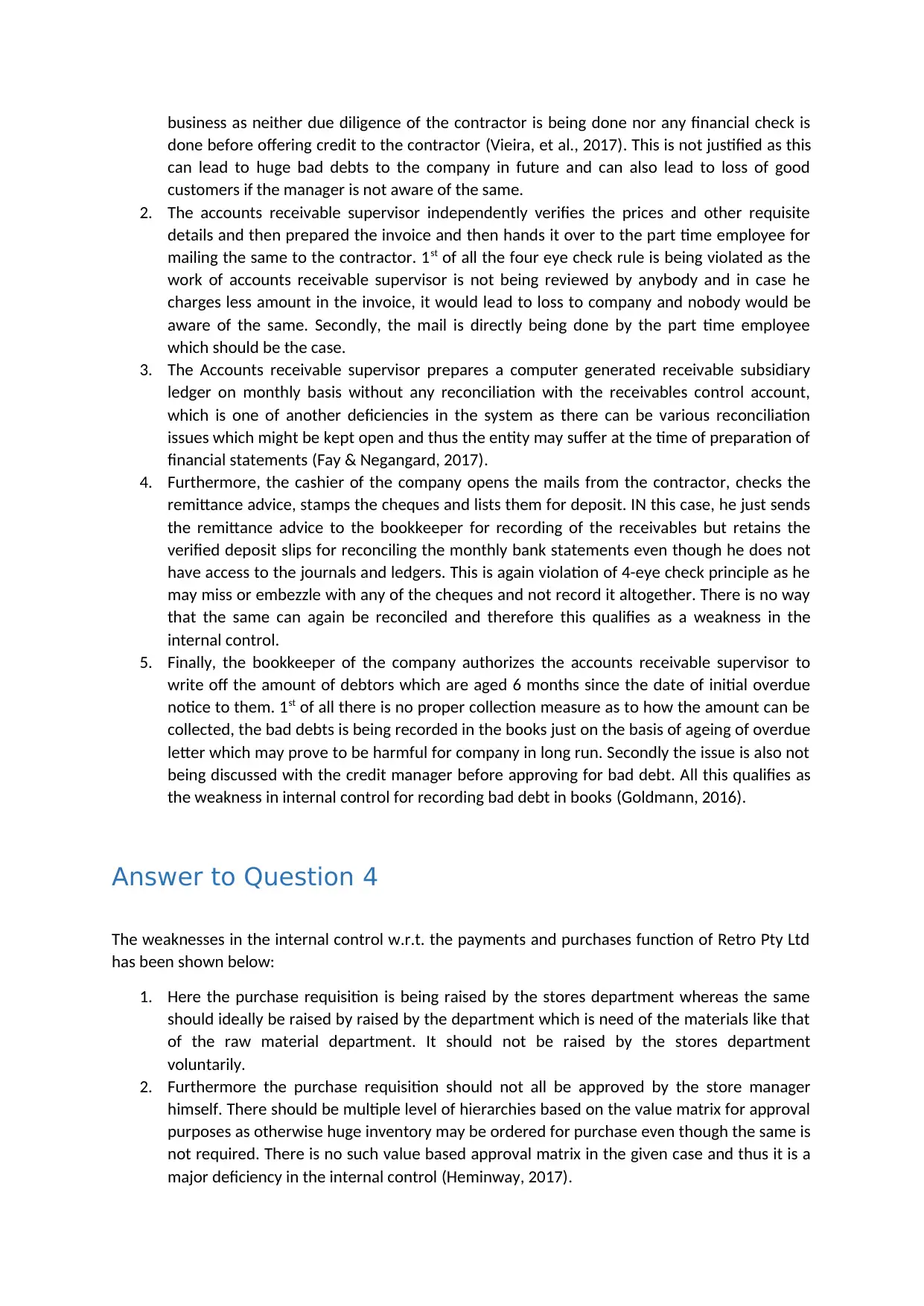
business as neither due diligence of the contractor is being done nor any financial check is
done before offering credit to the contractor (Vieira, et al., 2017). This is not justified as this
can lead to huge bad debts to the company in future and can also lead to loss of good
customers if the manager is not aware of the same.
2. The accounts receivable supervisor independently verifies the prices and other requisite
details and then prepared the invoice and then hands it over to the part time employee for
mailing the same to the contractor. 1st of all the four eye check rule is being violated as the
work of accounts receivable supervisor is not being reviewed by anybody and in case he
charges less amount in the invoice, it would lead to loss to company and nobody would be
aware of the same. Secondly, the mail is directly being done by the part time employee
which should be the case.
3. The Accounts receivable supervisor prepares a computer generated receivable subsidiary
ledger on monthly basis without any reconciliation with the receivables control account,
which is one of another deficiencies in the system as there can be various reconciliation
issues which might be kept open and thus the entity may suffer at the time of preparation of
financial statements (Fay & Negangard, 2017).
4. Furthermore, the cashier of the company opens the mails from the contractor, checks the
remittance advice, stamps the cheques and lists them for deposit. IN this case, he just sends
the remittance advice to the bookkeeper for recording of the receivables but retains the
verified deposit slips for reconciling the monthly bank statements even though he does not
have access to the journals and ledgers. This is again violation of 4-eye check principle as he
may miss or embezzle with any of the cheques and not record it altogether. There is no way
that the same can again be reconciled and therefore this qualifies as a weakness in the
internal control.
5. Finally, the bookkeeper of the company authorizes the accounts receivable supervisor to
write off the amount of debtors which are aged 6 months since the date of initial overdue
notice to them. 1st of all there is no proper collection measure as to how the amount can be
collected, the bad debts is being recorded in the books just on the basis of ageing of overdue
letter which may prove to be harmful for company in long run. Secondly the issue is also not
being discussed with the credit manager before approving for bad debt. All this qualifies as
the weakness in internal control for recording bad debt in books (Goldmann, 2016).
Answer to Question 4
The weaknesses in the internal control w.r.t. the payments and purchases function of Retro Pty Ltd
has been shown below:
1. Here the purchase requisition is being raised by the stores department whereas the same
should ideally be raised by raised by the department which is need of the materials like that
of the raw material department. It should not be raised by the stores department
voluntarily.
2. Furthermore the purchase requisition should not all be approved by the store manager
himself. There should be multiple level of hierarchies based on the value matrix for approval
purposes as otherwise huge inventory may be ordered for purchase even though the same is
not required. There is no such value based approval matrix in the given case and thus it is a
major deficiency in the internal control (Heminway, 2017).
done before offering credit to the contractor (Vieira, et al., 2017). This is not justified as this
can lead to huge bad debts to the company in future and can also lead to loss of good
customers if the manager is not aware of the same.
2. The accounts receivable supervisor independently verifies the prices and other requisite
details and then prepared the invoice and then hands it over to the part time employee for
mailing the same to the contractor. 1st of all the four eye check rule is being violated as the
work of accounts receivable supervisor is not being reviewed by anybody and in case he
charges less amount in the invoice, it would lead to loss to company and nobody would be
aware of the same. Secondly, the mail is directly being done by the part time employee
which should be the case.
3. The Accounts receivable supervisor prepares a computer generated receivable subsidiary
ledger on monthly basis without any reconciliation with the receivables control account,
which is one of another deficiencies in the system as there can be various reconciliation
issues which might be kept open and thus the entity may suffer at the time of preparation of
financial statements (Fay & Negangard, 2017).
4. Furthermore, the cashier of the company opens the mails from the contractor, checks the
remittance advice, stamps the cheques and lists them for deposit. IN this case, he just sends
the remittance advice to the bookkeeper for recording of the receivables but retains the
verified deposit slips for reconciling the monthly bank statements even though he does not
have access to the journals and ledgers. This is again violation of 4-eye check principle as he
may miss or embezzle with any of the cheques and not record it altogether. There is no way
that the same can again be reconciled and therefore this qualifies as a weakness in the
internal control.
5. Finally, the bookkeeper of the company authorizes the accounts receivable supervisor to
write off the amount of debtors which are aged 6 months since the date of initial overdue
notice to them. 1st of all there is no proper collection measure as to how the amount can be
collected, the bad debts is being recorded in the books just on the basis of ageing of overdue
letter which may prove to be harmful for company in long run. Secondly the issue is also not
being discussed with the credit manager before approving for bad debt. All this qualifies as
the weakness in internal control for recording bad debt in books (Goldmann, 2016).
Answer to Question 4
The weaknesses in the internal control w.r.t. the payments and purchases function of Retro Pty Ltd
has been shown below:
1. Here the purchase requisition is being raised by the stores department whereas the same
should ideally be raised by raised by the department which is need of the materials like that
of the raw material department. It should not be raised by the stores department
voluntarily.
2. Furthermore the purchase requisition should not all be approved by the store manager
himself. There should be multiple level of hierarchies based on the value matrix for approval
purposes as otherwise huge inventory may be ordered for purchase even though the same is
not required. There is no such value based approval matrix in the given case and thus it is a
major deficiency in the internal control (Heminway, 2017).
Paraphrase This Document
Need a fresh take? Get an instant paraphrase of this document with our AI Paraphraser
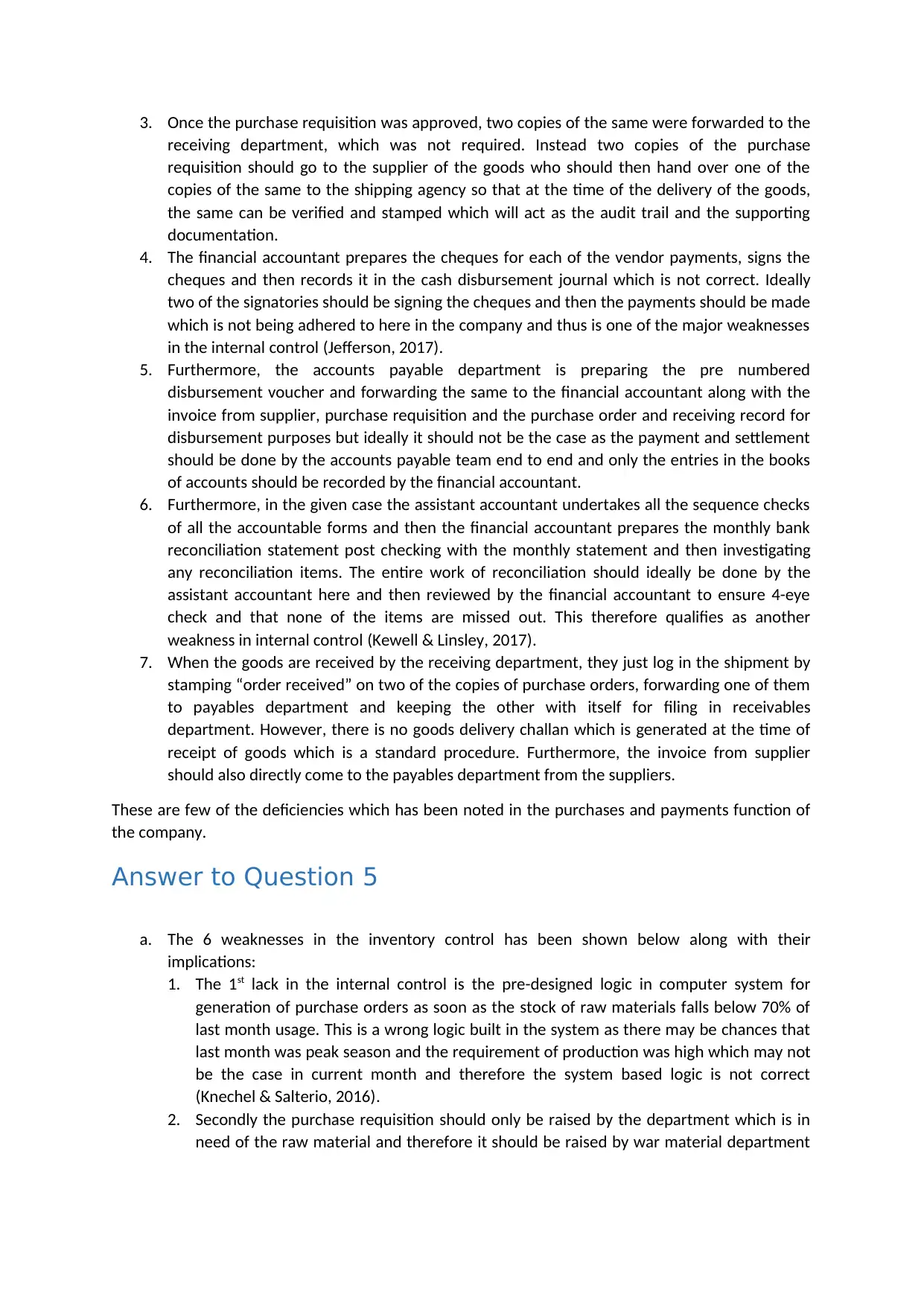
3. Once the purchase requisition was approved, two copies of the same were forwarded to the
receiving department, which was not required. Instead two copies of the purchase
requisition should go to the supplier of the goods who should then hand over one of the
copies of the same to the shipping agency so that at the time of the delivery of the goods,
the same can be verified and stamped which will act as the audit trail and the supporting
documentation.
4. The financial accountant prepares the cheques for each of the vendor payments, signs the
cheques and then records it in the cash disbursement journal which is not correct. Ideally
two of the signatories should be signing the cheques and then the payments should be made
which is not being adhered to here in the company and thus is one of the major weaknesses
in the internal control (Jefferson, 2017).
5. Furthermore, the accounts payable department is preparing the pre numbered
disbursement voucher and forwarding the same to the financial accountant along with the
invoice from supplier, purchase requisition and the purchase order and receiving record for
disbursement purposes but ideally it should not be the case as the payment and settlement
should be done by the accounts payable team end to end and only the entries in the books
of accounts should be recorded by the financial accountant.
6. Furthermore, in the given case the assistant accountant undertakes all the sequence checks
of all the accountable forms and then the financial accountant prepares the monthly bank
reconciliation statement post checking with the monthly statement and then investigating
any reconciliation items. The entire work of reconciliation should ideally be done by the
assistant accountant here and then reviewed by the financial accountant to ensure 4-eye
check and that none of the items are missed out. This therefore qualifies as another
weakness in internal control (Kewell & Linsley, 2017).
7. When the goods are received by the receiving department, they just log in the shipment by
stamping “order received” on two of the copies of purchase orders, forwarding one of them
to payables department and keeping the other with itself for filing in receivables
department. However, there is no goods delivery challan which is generated at the time of
receipt of goods which is a standard procedure. Furthermore, the invoice from supplier
should also directly come to the payables department from the suppliers.
These are few of the deficiencies which has been noted in the purchases and payments function of
the company.
Answer to Question 5
a. The 6 weaknesses in the inventory control has been shown below along with their
implications:
1. The 1st lack in the internal control is the pre-designed logic in computer system for
generation of purchase orders as soon as the stock of raw materials falls below 70% of
last month usage. This is a wrong logic built in the system as there may be chances that
last month was peak season and the requirement of production was high which may not
be the case in current month and therefore the system based logic is not correct
(Knechel & Salterio, 2016).
2. Secondly the purchase requisition should only be raised by the department which is in
need of the raw material and therefore it should be raised by war material department
receiving department, which was not required. Instead two copies of the purchase
requisition should go to the supplier of the goods who should then hand over one of the
copies of the same to the shipping agency so that at the time of the delivery of the goods,
the same can be verified and stamped which will act as the audit trail and the supporting
documentation.
4. The financial accountant prepares the cheques for each of the vendor payments, signs the
cheques and then records it in the cash disbursement journal which is not correct. Ideally
two of the signatories should be signing the cheques and then the payments should be made
which is not being adhered to here in the company and thus is one of the major weaknesses
in the internal control (Jefferson, 2017).
5. Furthermore, the accounts payable department is preparing the pre numbered
disbursement voucher and forwarding the same to the financial accountant along with the
invoice from supplier, purchase requisition and the purchase order and receiving record for
disbursement purposes but ideally it should not be the case as the payment and settlement
should be done by the accounts payable team end to end and only the entries in the books
of accounts should be recorded by the financial accountant.
6. Furthermore, in the given case the assistant accountant undertakes all the sequence checks
of all the accountable forms and then the financial accountant prepares the monthly bank
reconciliation statement post checking with the monthly statement and then investigating
any reconciliation items. The entire work of reconciliation should ideally be done by the
assistant accountant here and then reviewed by the financial accountant to ensure 4-eye
check and that none of the items are missed out. This therefore qualifies as another
weakness in internal control (Kewell & Linsley, 2017).
7. When the goods are received by the receiving department, they just log in the shipment by
stamping “order received” on two of the copies of purchase orders, forwarding one of them
to payables department and keeping the other with itself for filing in receivables
department. However, there is no goods delivery challan which is generated at the time of
receipt of goods which is a standard procedure. Furthermore, the invoice from supplier
should also directly come to the payables department from the suppliers.
These are few of the deficiencies which has been noted in the purchases and payments function of
the company.
Answer to Question 5
a. The 6 weaknesses in the inventory control has been shown below along with their
implications:
1. The 1st lack in the internal control is the pre-designed logic in computer system for
generation of purchase orders as soon as the stock of raw materials falls below 70% of
last month usage. This is a wrong logic built in the system as there may be chances that
last month was peak season and the requirement of production was high which may not
be the case in current month and therefore the system based logic is not correct
(Knechel & Salterio, 2016).
2. Secondly the purchase requisition should only be raised by the department which is in
need of the raw material and therefore it should be raised by war material department

only and not by anyone else, which is another major deficiency in internal control. It may
lead to unnecessary rise in the stocks of raw materials (Meroño-Cerdán, et al., 2017).
3. Again in the production procedures for the finished goods, the production orders are
automatically being generated by the computer system as soon as the finished goods
falls below 60% of the prior month sales which should not be the case as there might be
a scenario that last month the sales and demand was high and this month same can be
on lower side so using the same scale may not be a good idea.
4. Furthermore, there is no check on the raw material issue to the supplier for generation
of finished goods and it is a serious deficiency in internal control as it can lead to huge
reconciliation issues and loss of raw materials and therefore the same should be tracked
based on some ratio and only the requisite amount of raw materials should be issued to
production department or supplier (Linden & Freeman, 2017).
5. In terms of the password, the access of master data changes w.r.t. the production orders
should not be in the hands of production controller and similarly the Masterfile
amendments access should only be allowed to accounts clerk only in the specific
circumstances and with the requisite approvals in place or it may have an implication
that master data is changed unnecessarily by accounts clerk and order is placed on
wrong supplier which may lead to quality issues, delaying of delivery, etc. Currently it is
solely done by production controller based on one amendment form but ideally there
should be a dual review here in case of Masterfile changes (Kangarluie & Aalizadeh,
2017).
6. The computer automatically selects the supplier of raw material as well as finished
goods based on last price and delivery timelines which is wrong as it ignores may of the
parameters like quotations is missing, quality issue is compromised, distance between
supplier and delivery location is ignored which may have a bearing on transportation
costs, and hence the same should be taken into account or else the company may bear
losses.
b. IN case the IT audit division is to perform the testing of the existing controls for the
inventory system which has been described above, the two tests should be:
1. The entire IT system which is there for generation of purchase orders and production
orders based on last month’s procurement and production should be checked for its
efficiency and correctly as to whether it is generating purchase orders at the right time
and whether it is leading to overstocking or understocking.
2. Secondly, the IT team should also check on the Masterfile changes which have been
done in the last 1-2 years and whether there was any basis of doing that with the
requisite supporting (Sithole, et al., 2017).
lead to unnecessary rise in the stocks of raw materials (Meroño-Cerdán, et al., 2017).
3. Again in the production procedures for the finished goods, the production orders are
automatically being generated by the computer system as soon as the finished goods
falls below 60% of the prior month sales which should not be the case as there might be
a scenario that last month the sales and demand was high and this month same can be
on lower side so using the same scale may not be a good idea.
4. Furthermore, there is no check on the raw material issue to the supplier for generation
of finished goods and it is a serious deficiency in internal control as it can lead to huge
reconciliation issues and loss of raw materials and therefore the same should be tracked
based on some ratio and only the requisite amount of raw materials should be issued to
production department or supplier (Linden & Freeman, 2017).
5. In terms of the password, the access of master data changes w.r.t. the production orders
should not be in the hands of production controller and similarly the Masterfile
amendments access should only be allowed to accounts clerk only in the specific
circumstances and with the requisite approvals in place or it may have an implication
that master data is changed unnecessarily by accounts clerk and order is placed on
wrong supplier which may lead to quality issues, delaying of delivery, etc. Currently it is
solely done by production controller based on one amendment form but ideally there
should be a dual review here in case of Masterfile changes (Kangarluie & Aalizadeh,
2017).
6. The computer automatically selects the supplier of raw material as well as finished
goods based on last price and delivery timelines which is wrong as it ignores may of the
parameters like quotations is missing, quality issue is compromised, distance between
supplier and delivery location is ignored which may have a bearing on transportation
costs, and hence the same should be taken into account or else the company may bear
losses.
b. IN case the IT audit division is to perform the testing of the existing controls for the
inventory system which has been described above, the two tests should be:
1. The entire IT system which is there for generation of purchase orders and production
orders based on last month’s procurement and production should be checked for its
efficiency and correctly as to whether it is generating purchase orders at the right time
and whether it is leading to overstocking or understocking.
2. Secondly, the IT team should also check on the Masterfile changes which have been
done in the last 1-2 years and whether there was any basis of doing that with the
requisite supporting (Sithole, et al., 2017).

References
Alexander, F., 2016. The Changing Face of Accountability. The Journal of Higher Education, 71(4), pp.
411-431.
Choy, Y. K., 2018. Cost-benefit Analysis, Values, Wellbeing and Ethics: An Indigenous Worldview
Analysis. Ecological Economics, 2(1), p. 145.
Dichev, I., 2017. On the conceptual foundations of financial reporting. Accounting and Business
Research, 47(6), pp. 617-632.
Fay, R. & Negangard, E., 2017. Manual journal entry testing : Data analytics and the risk of fraud.
Journal of Accounting Education, Volume 38, pp. 37-49.
Goldmann, K., 2016. Financial Liquidity and Profitability Management in Practice of Polish Business.
Financial Environment and Business Development, Volume 4, pp. 103-112.
Heminway, J., 2017. Shareholder Wealth Maximization as a Function of Statutes, Decisional Law, and
Organic Documents. SSRN, 5(2), pp. 1-35.
Jefferson, M., 2017. Energy, Complexity and Wealth Maximization, R. Ayres. Springer, Switzerland.
Technological Forecasting and Social Change, 1(2), pp. 353-354.
Kangarluie, S. & Aalizadeh, A., 2017. 'The expectation gap in auditing. Accounting, 3(1), pp. 19-22.
Kewell, B. & Linsley, P., 2017. Risk tools and risk technologies.. The Routledge Companion to
Accounting and Risk, 15, 3(1), pp. 22-35.
Knechel, W. & Salterio, S., 2016. Auditing:Assurance and Risk. fourth ed. New York: Routledge.
Linden, B. & Freeman, R., 2017. Profit and Other Values: Thick Evaluation in Decision Making.
Business Ethics Quarterly, 27(3), pp. 353-379.
Meroño-Cerdán, A., Lopez-Nicolas, C. & Molina-Castillo, F., 2017. Risk aversion, innovation and
performance in family firms. Economics of Innovation and new technology, 7(1), pp. 1-15.
Sithole, S., Chandler, P., Abeysekera, I. & Paas, F., 2017. Benefits of guided self-management of
attention on learning accounting. Journal of Educational Psychology, 109(2), p. 220.
Vieira, R., O’Dwyer, B. & Schneider, R., 2017. Aligning Strategy and Performance Management
Systems. SAGE Journals, 30(1), pp. 25-32.
Visinescu, L., Jones, M. & Sidorova, A., 2017. Improving Decision Quality: The Role of Business
Intelligence. Journal of Computer Information Systems, 57(1), pp. 58-66.
Werner, M., 2017. Financial process mining - Accounting data structure dependent control flow
inference. International Journal of Accounting Information Systems, Volume 25, pp. 57-80.
Alexander, F., 2016. The Changing Face of Accountability. The Journal of Higher Education, 71(4), pp.
411-431.
Choy, Y. K., 2018. Cost-benefit Analysis, Values, Wellbeing and Ethics: An Indigenous Worldview
Analysis. Ecological Economics, 2(1), p. 145.
Dichev, I., 2017. On the conceptual foundations of financial reporting. Accounting and Business
Research, 47(6), pp. 617-632.
Fay, R. & Negangard, E., 2017. Manual journal entry testing : Data analytics and the risk of fraud.
Journal of Accounting Education, Volume 38, pp. 37-49.
Goldmann, K., 2016. Financial Liquidity and Profitability Management in Practice of Polish Business.
Financial Environment and Business Development, Volume 4, pp. 103-112.
Heminway, J., 2017. Shareholder Wealth Maximization as a Function of Statutes, Decisional Law, and
Organic Documents. SSRN, 5(2), pp. 1-35.
Jefferson, M., 2017. Energy, Complexity and Wealth Maximization, R. Ayres. Springer, Switzerland.
Technological Forecasting and Social Change, 1(2), pp. 353-354.
Kangarluie, S. & Aalizadeh, A., 2017. 'The expectation gap in auditing. Accounting, 3(1), pp. 19-22.
Kewell, B. & Linsley, P., 2017. Risk tools and risk technologies.. The Routledge Companion to
Accounting and Risk, 15, 3(1), pp. 22-35.
Knechel, W. & Salterio, S., 2016. Auditing:Assurance and Risk. fourth ed. New York: Routledge.
Linden, B. & Freeman, R., 2017. Profit and Other Values: Thick Evaluation in Decision Making.
Business Ethics Quarterly, 27(3), pp. 353-379.
Meroño-Cerdán, A., Lopez-Nicolas, C. & Molina-Castillo, F., 2017. Risk aversion, innovation and
performance in family firms. Economics of Innovation and new technology, 7(1), pp. 1-15.
Sithole, S., Chandler, P., Abeysekera, I. & Paas, F., 2017. Benefits of guided self-management of
attention on learning accounting. Journal of Educational Psychology, 109(2), p. 220.
Vieira, R., O’Dwyer, B. & Schneider, R., 2017. Aligning Strategy and Performance Management
Systems. SAGE Journals, 30(1), pp. 25-32.
Visinescu, L., Jones, M. & Sidorova, A., 2017. Improving Decision Quality: The Role of Business
Intelligence. Journal of Computer Information Systems, 57(1), pp. 58-66.
Werner, M., 2017. Financial process mining - Accounting data structure dependent control flow
inference. International Journal of Accounting Information Systems, Volume 25, pp. 57-80.
Secure Best Marks with AI Grader
Need help grading? Try our AI Grader for instant feedback on your assignments.

1 out of 8
![[object Object]](/_next/static/media/star-bottom.7253800d.svg)





